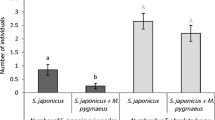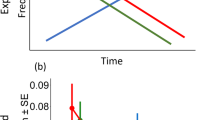Summary
This study investigates the mechanisms of competition between congeneric pairs of insectivorous mammals in two communities in Australia and England. Direct field observations showed that physical interactions between species do not occur, whereas conspecific encounters are frequent. In field enclosures the smaller, subordinate species in each community (Antechinus stuartii: Marsupialia: Sorex minutus: Eutheria) remained alert in the presence of the dominant species (A. swainsonii, S. araneus), and moved quickly away when the latter approached. The rate of prey capture by subordinate individuals also increased immediately after removal of the dominants. Hourly removals of some individuals of the dominant species in each community over 24 h produced hourly increases in the numbers of subordinate individuals that were captured. The rapidity of these responses suggests strongly that the dominant insectivores in each community interfered with the resource use of the subordinate species. Biomass of invertebrates increased inconsistently or slowly within 3 months of removal of the dominant insectivores; hence the rapid responses by subordinate individuals in experiments were not due to simple exploitation or tracking of resource levels. The subordinate insectivores probably detected and avoided contact with dominants instantaneously using auditory or olfactory cues; reciprocal avoidance of congeneric odours was demonstrated using odour-scented traps. Insectivorous mammals may usually compete by interference (or encounter competition, sensu Schoener 1983). For dominant species within communities the cost of interference is minimal and the benefit of gaining exclusive access to resource-rich microhabitats is high. Conversely for subordinate species the benefit of temporarily exploiting the same rich microhabitats may exceed the small costs of vigilance and movement to nearby refugia.
Similar content being viewed by others
References
Abramsky Z, Pinshow B (1989) Changes in foraging effort in two gerbil species correlate with habitat type and intra-and interspecific activity. Oikos 56:43–53
Barnett SA, Spencer MM (1951) Feeding, social behaviour and interspecific competition in wild rats. Behaviour 3:229–242
Brown JH (1971) Mechanisms of competitive exclusion between two species of chipmunks. Ecology 52:305–311
Buchler ER (1976) A chemiluminescent tag for tracking bats and other small nocturnal animals. J Mammal 57:173–176
Case TJ, Gilpin ME (1974) Interference competition and niche theory. Proc Nat Acad Sci USA 71:3073–3077
Churchfield S (1982) Food availability and the diet of the common shrew, Sorex araneus, in Britain. J Anim Ecol 51:15–28
Crowcroft P (1957) The life of the shrew. Max Reinhardt, London
Daly M, Wilson MI, Behrends P (1980) Factors affecting rodents' responses to odours of strangers encountered in the field: experiments with odour-baited traps. Behav Ecol Socio-biol 6:323–329
Dickman CR (1982) Some ecological aspects of seasonal breeding in Antechinus (Dasyuridae, Marsupialia). In: Archer M (ed) Carnivorous marsupials. Roy Zool Soc New South Wales, Sydney, pp 139–150
Dickman CR (1986a) An experimental study of competition between two species of dasyurid marsupials. Ecol Monogr 56:221–241
Dickman CR (1986b) An experimental manipulation of the intensity of interspecific competition: effects on a small marsupial. Oecologia 70:536–543
Dickman CR (1988a) Body size, prey size, and community structure in insectivorous mammals. Ecology 69:569–580
Dickman CR (1988b) Detection of physical contact interactions among free-living mammals. J Mammal 69:865–868
Dickman CR (1989) Demographic responses of Antechinus stuartii (Marsupialia) to supplementary food. Aust J Ecol 14:387–398
Dickman CR, Doncaster CP (1987) The ecology of small mammals in urban habitats. I. Populations in a patchy environment. J Anim Ecol 56:629–640
Dickman CR, Woodside DP (1983) A test of a competition model with reference to three species of small mammals in south-eastern Australia. Oecologia 60:127–134
Dow DD (1977) Indiscriminate interspecific aggression leading to almost sole occupancy of space by a single species of bird. Emu 77:115–121
Florence RG (ed) (1973) A resource and management survey of the Cotter River catchment. Dept Forestry, Australian National University, Canberra
Fox BJ, Pople AR (1984) Experimental confirmation of interspecific competition between native and introduced mice. Aust J Ecol 9:323–334
Fretwell SD (1972) Populations in a seasonal environment. Princeton University Press, New Jersey
Frye RJ (1983) Experimental field evidence of interspecific aggression between two species of kangaroo rat (Dipodomys). Oecologia 59:74–78
Gliwicz J (1981) Competitive interactions within a forest rodent community in central Poland. Oikos 37:353–362
Green RH (1972) The murids and small dasyurids in Tasmania. Part 5, Antechinus swainsonii (Waterhouse 1840). Rec Queen Vict Mus 46:1–13
Greenwood PJ (1978) Timing of activity of the bank vole Clethrionomys glareolus and the wood mouse Apodemus sylvaticus in a deciduous woodland. Oikos 31:123–127
Hall S (1980) The diets of two coexisting species of Antechinus (Marsupialia: Dasyuridae). Aust Wildl Res 7:365–378
Hall S, Lee AK (1982) Habitat use by two species of Antechinus and Rattus fuscipes in tall open forest in southern Victoria. In: Archer M (ed) Carnivorous marsupials. Roy Zool Soc New South Wales, Sydney, pp 209–220
Hawes ML (1976) Odor as a possible isolating mechanism in sympatric species of shrews (Sorex vagrans and Sorex obscurus). J Mammal 57:404–406
Hoffmeyer I (1973) Interaction and habitat selection in the mice Apodemus flavicollis and A. sylvaticus. Oikos 24:108–116
Holisova V (1969) Vertical movements of some small mammals in a forest. Zool Listy 18:121–141
Jaeger RG, Gergits WF (1979) Intra - and interspecific communication in salamanders through chemical signals on the substrate. Anim Behav 27:150–156
King CM, Moors PJ (1979) On co-existence, foraging strategy and the biogeography of weasels and stoats (Mustela nivalis and M. erminea) in Britain. Oecologia 39:129–150
Krebs CJ (1966) Demographic changes in fluctuating populations of Microtus californicus. Ecol Monogr 36:239–273
Lemen CA, Freeman PW (1983) Quantification of competition among coexisting heteromyids in the southwest. Southwest Nat 28:41–46
Lemen CA, Freeman PW (1986) Interference competition in a heteromyid community in the Great Basin of Nevada, USA. Oikos 46:390–396
Miller RS (1967) Pattern and process in competition. Adv Ecol Res 4:1–74
Miller RS (1969) Competition and species diversity. Brookhaven Symp Biol 22:63–70
Montgomery WI (1981) A removal experiment with sympatric populations of Apodemus sylvaticus (L.) and A. flavicollis (Melchior) (Rodentia: Muridae). Oecologia 51:123–132
Moore RE (1965) Olfactory discrimination as an isolating mechanism between Peromyscus maniculatus and Peromyscus polionotus. Am Midl Nat 73:85–100
Morse DH (1971a) The foraging of warblers isolated on small islands. Ecology 52:216–228
Morse DH (1971b) The insectivorous bird as an adaptive strategy. Ann Rev Ecol Syst 2:177–200
Munger JC, Brown JH (1981) Competition in desert rodents: an experiment with semipermeable exclosures. Science 211:510–512
Nishikawa KC (1987) Interspecific aggressive behaviour in salamanders: species — specific interference or misidentification? Anim Behav 35:263–270
Oksanen L, Fretwell SD, Jarvinen O (1979) Interspecific aggression and the limiting similarity of close competitors: the problem of size gaps in some community arrays. Am Nat 114:117–129
Park T (1954) Experimental studies of interspecies competition. II. Temperature, humidity, and competition in two species of Tribolium. Physiol Zool 27:177–238
Pernetta JC (1976) Diets of the shrews Sorex araneus L. and Sorex minutus L. in Wytham grassland. J Anim Ecol 45:899–912
Poduschka W (1977) Insectivore communication. In: Seboek TA (ed) How animals communicate. Indiana University Press, Bloomington, pp 600–633
Randall JA (1981) Olfactory communication at sandbathing loci by sympatric species of kangaroo rats. J Mammal 62:12–19.
Roudebush RE, Taylor DH (1987) Chemical communication between two species of desmognathine salamanders. Copeia 1987:744–748
Sales G, Pye D (1974) Ultrasonic communication by animals. Chapman and Hall, London
Schoener TW (1983) Field experiments on interspecific competition. Am Nat 122:240–285
Schroder GD (1987) Mechanisms for coexistence among three species of Dipodomys: habitat selection and an alternative. Ecology 68:1071–1083
Simms DA (1979) North American weasels: resource utilization and distribution. Can J Zool 57:504–520
Simpson GG, Roe A, Lewontin RC (1960). Quantitative zoology. Harcourt, Brace & Co, New York
Southerland MT (1986) Behavioral interactions among four species of the salamander genus Desmognathus. Ecology 67:175–181
Steinwascher K (1978) Interference and exploitation competition among tadpoles of Rana utricularia. Ecology 59:1039–1046
Stoddart DM (1980) The ecology of vertebrate olfaction. Chapman and Hall, London
Thomson JA, Pears FN (1962) The functions of the anal glands of the brushtail possum. Vict Nat 78:306–308
Tilman D (1987) The importance of the mechanisms of interspecific competition. Am Nat 129:769–774
Wolff JO, Freeberg MH, Dueser RD (1983) Interspecific territoriality in two sympatric species of Peromyscus (Rodentia: Cricetidae). Behav Ecol Sociobiol 12:237–242
Author information
Authors and Affiliations
Rights and permissions
About this article
Cite this article
Dickman, C.R. Mechanisms of competition among insectivorous mammals. Oecologia 85, 464–471 (1991). https://doi.org/10.1007/BF00323757
Received:
Accepted:
Issue Date:
DOI: https://doi.org/10.1007/BF00323757




